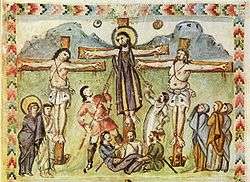Rabbula Gospels

The Rabbula Gospels, or Rabula Gospels, (Florence, Biblioteca Mediceo Laurenziana, cod. Plut. I, 56) is a 6th-century illuminated Syriac Gospel Book. One of the finest Byzantine works produced in Asia, and one of the earliest Christian manuscripts with large miniatures, it is distinguished by the miniaturist's predilection for bright colours, movement, drama, and expressionism. Coming from a period from which little art survives, and which saw great development in Christian iconography, the manuscript has a significant place in art history, and is very often referred to.
Recent scholarship suggests that in fact the manuscript as it currently exists was put together in the 15th century, and that the miniature illustrations were originally from one or more different books.
Description

The Gospel was completed in 586 at Monastery of St. John of Zagba (Syriac: ܒܝܬ ܙܓܒܐ, Bēṯ Zaḡbā), which, although traditionally thought to have been in Northern Mesopotamia, is now thought to have been in the hinterland between Antioch and Apamea in modern Syria. It was signed by its scribe, Rabbula (ܪܒܘܠܐ, Rabbulā) about whom nothing else is known. In their current condition the folios are 34 cm (13.4 in) by 27 cm (10.6 in). Their original size is unknown because they were trimmed during previous rebindings. The text is written in black or dark brown ink in two columns of a variable number of lines. There are footnotes written in red ink at the bottom of many of the columns. The text is the Peshitta version of the Syriac translation of the Gospels.
The manuscript is illuminated, with the text framed in elaborate floral and architectural motifs. The Gospel canons are set in arcades ornamented with flowers and birds. The miniaturist obviously drew some of his inspiration from Hellenistic art (draped figures), but relied mainly on the ornamental traditions of Persia. The miniatures of the Rabbula Gospels, notably those representing the Crucifixion, the Ascension and Pentecost, are real pictures with a decorative frame formed of zigzags, curves, rainbows and so forth. The scene of the Crucifixion is the earliest to survive in an illuminated manuscript, and shows the Eastern form of the image at the time. There is a miniature of the Apostles choosing a new twelfth member (after the loss of Judas); this is not an event found in the Canonical Gospels (though it is mentioned in Chapter 1 of Acts) and is almost never seen in later art. The artist was trained in the classical illusionist tradition, and is a competent and practiced hand rather than an outstanding talent; but surviving images from this period are so rare that his are extremely valuable for showing the style and iconography of his age.

The French Orientalist Edgard Blochet (1870–1937) argued that some of the folios of the manuscript, including the pictorial series, were an interpolation no earlier than the 10th or 11th century. Since the original caption accompanying the miniatures is of the same paleographic character as the main text of the manuscript, this theory was rejected by Giuseppe Furlani and by Carlo Cecchelli in the commentary of the facsimile edition of the miniatures published in 1959.[1] But doubts as to the original unity of the contents continued.[2] More recently, scholars have proposed that the text of 586 was only bound up together with the miniatures in the 15th century, and that the miniatures themselves were taken from at least one other original manuscript, and come from two different campaigns of work.[3]
The history of the manuscript after it was written is vague until the 11th century when it was at Maipuc. In the late 13th or early 14th century it came to Quannubin. In the late 15th or early 16th century, the manuscript was taken by the Maronite Patriarch to the Laurentian Library in Florence, where it is today.
Large miniatures
- fol. 1a Election of the Apostle Mathias by the Eleven
- fol. 1b Theotokos (Virgin Mary) with the infant Jesus
- fol. 2a Christ receives a book from two monks (dedication) / The saints Eusebius of Caesarea and Ammonius of Alexandria
- fol. 3b-12b The canon tables of Eusebius with smaller marginal miniatures
- fol. 9b Matthew and John
- fol. 13a Crucifixion of Christ / Three Marys at the tomb
- fol. 14a Ascension of Christ / Christ with four monks
- fol. 14b Gift of the Holy Spirit at Pentecost
See also
References
- ↑ Miniatures from the Rabbula Gospels ms.
- ↑ Wright, David H. "The Date and Arrangement of the Illustrations in the Rabbula Gospels." Dumbarton Oaks Papers 27 (1973): 197-208. Web., JSTOR
- ↑ Otter, Monica, review of Bernabò (see Further reading
- Walther, Ingo F.; Wolf, Norbert (2005), Codices Illustres: The world's most famous illuminated manuscripts, 400 to 1600, Köln: Taschen.
- Weitzmann, Kurt (1977), Late Antique and Early Christian Book Illumination, New York: George Braziller.
Further reading
- Weitzmann, Kurt, ed., Age of spirituality : late antique and early Christian art, third to seventh century, no. 445, 1979, Metropolitan Museum of Art, New York, ISBN 9780870991790; full text available online from The Metropolitan Museum of Art Libraries
- Il Tetravangelo di Rabbula. Firenze, Biblioteca Medicea Laurenziana, cod. Plut. 1.56. L’illustrazione del Nuovo Testamento nella Siria del VI secolo, a cura di Massimo Bernabò, Roma, 2008.
External links
| Wikimedia Commons has media related to Rabbula Gospels. |
- The manuscript page-by-page online
- Blog with up-to-date bibliography
- Grove Dictionary of Art (Rabbula Gospels)
- Homepage des Bistums Speyer (mit Kommentaren zu einzelnen Bildern)